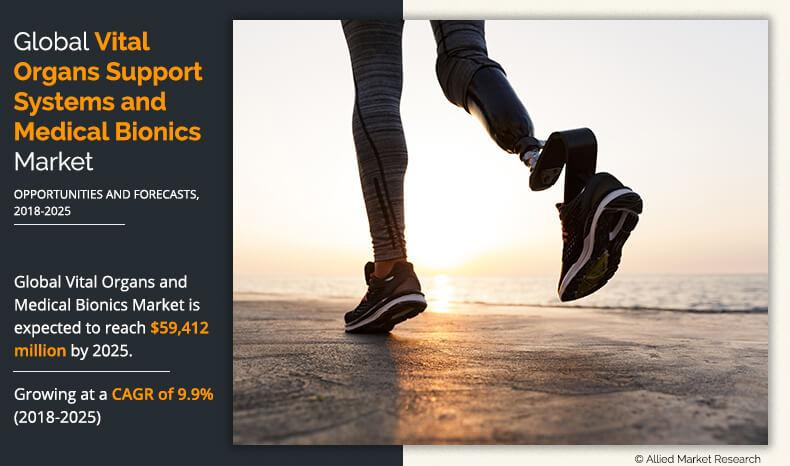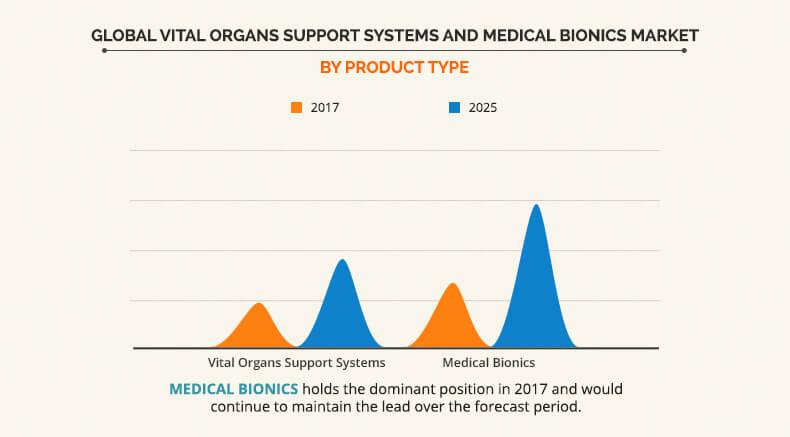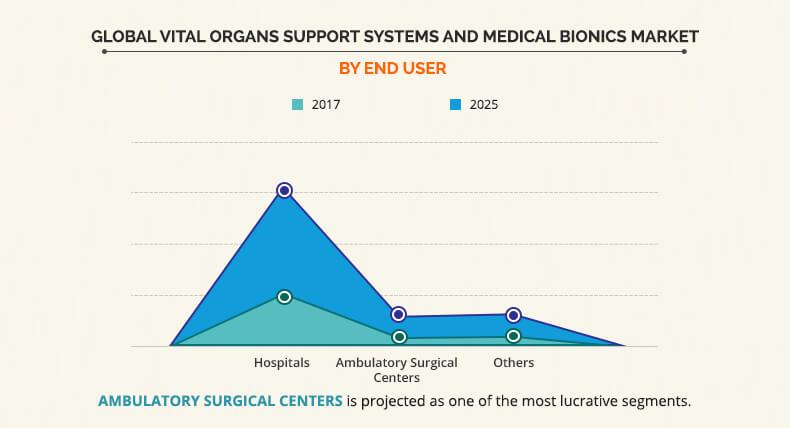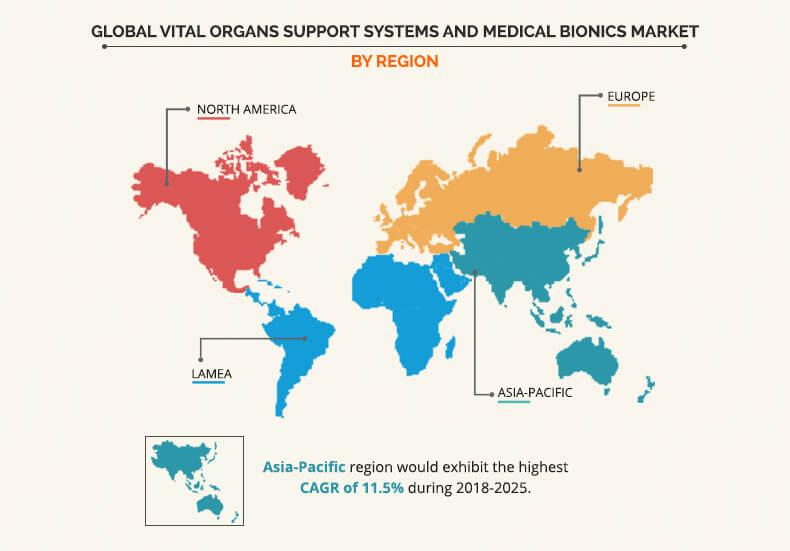Vital Organs Support Systems and Medical Bionics Market Outlook - 2025
The global vital organs support systems and medical bionics market size in 2017 was $28,169 million, and is projected to reach $59,412 million by 2025, growing at a CAGR of 9.9% from 2018 to 2025.
Artificial organ is a device designed to replace the functions of missing or faulty organ, thereby restoring the functions of original organ. Medical bionics refers to the study of artificial body parts that are substituted for a natural biological capability. Organ transplantation has evolved as a common practice, which has fueled the development of the healthcare industry. High demand has been witnessed from patients for organ transplantation surgery, whereas availability of the donors to meet this demand is low. This has resulted in a wider supply–demand gap, which in turn has aided in increasing the global vital organs support systems and medical bionics market share.
The growth of the global market is driven by rise in incidence of cardiac disorders and upsurge in geriatric population. In addition, rise in number of patients suffering from chronic diseases and technological advancements in medical devices drive the vital organs support systems and medical bionics market growth. However, high cost of treatment and stringent approval process are projected to impede the growth of the market. On the contrary, lucrative opportunities in emerging economies are expected to provide significant prospects for the manufacturers in the industry.
Product segment review
Based on product, the vital organs support systems and medical bionics market is categorized into vital organs support systems and medical bionics. The vital organs support systems market is further classified into artificial heart, artificial kidney, artificial pancreas, artificial urinary bladder, artificial lungs, and artificial liver. The medical bionics market is subsegmented into bionic eye, ear bionics, orthopedic bionics, cardiac bionics, and neural bionics. The medical bionics segment was the major revenue contributor in 2017, and is anticipated to continue this trend during the forecast period, owing to rise in geriatric population, upsurge in number of patients suffering from chronic diseases, and increase in government focus on funding R&D initiatives.
End user segment review
Depending on end user, the vital organs support systems and medical bionics market is fragmented into hospitals, ambulatory surgical centers, and others. The ambulatory surgical centers segment is projected to exhibit the highest growth during the forecast period. This is attributed to surge in demand for high-quality, cost-effective alternative to inpatient hospital care for surgical services. However, the hospitals segment was the major revenue contributor in 2017, and is anticipated to continue this trend during the forecast period, owing to the availability of various support departments such as MRI suites and ICUs as compared to ASCs. In addition, hospitals have more resources to manage complications, and patients are often transferred from an ambulatory surgery center to the nearest hospital when complications arise during a procedure.
Region segment review
Region wise, the vital organs support systems and medical bionics market is analyzed across North America, Europe, Asia-Pacific, and LAMEA. Asia-Pacific is projected to exhibit the highest growth during the vital organs support systems and medical bionics market forecast period, owing to government & private sector initiatives to increase awareness regarding artificial organs transplantation, increase in R&D expenditure, and increase in incidence of chronic disorders.
The report provides a comprehensive vital organs support systems and medical bionics market analysis of the key players operating in the global market, namely, Abiomed, Inc., Abbott Laboratories, Asahi Kasei Corporation (Evaheart Medical U.S.A., Inc.), Baxter International Inc., Boston Scientific Corporation, Cochlear Ltd., Edwards Lifesciences Corporation, Jarvik Heart, Inc., Medtronic Plc., Össur Americas, Inc., Second Sight Medical Products, Inc., and SynCardia Systems LLC. The other players in the value chain include Getinge AB, LivaNova PLC, Fresenius Medical Care AG & Co. KGaA, Heartware International Inc., BiVACOR, and others.
Key Benefits for Vital Organs Support Systems and Medical Bionics Market:
- This report provides a detailed quantitative analysis of the current vital organs support systems and medical bionics market trends and estimations from 2018 to 2025, which assists to identify the prevailing vital organs support systems and medical bionics market opportunities.
- An in-depth vital organs support systems and medical bionics market analysis of various regions is anticipated to provide a detailed understanding of the current trends to enable stakeholders formulate region-specific plans.
- A comprehensive analysis of the factors that drive and restrain the growth of the global vital organs support systems and medical bionics market is provided.
- Region-wise and country-wise vital organs support systems and medical bionics market conditions are comprehensively analyzed in this report.
- The projections in this report are made by analyzing the current trends and future market potential from 2018 to 2025 in terms of value.
- An extensive analysis of various regions provides insights that are expected to allow companies to strategically plan their business moves.
- Key market players within the vital organs support systems and medical bionics market are profiled in this report and their strategies are analyzed thoroughly, which helps to understand the competitive outlook of the global market.
Vital Organs Support Systems and Medical Bionics Market Report Highlights
| Aspects | Details |
| By Product Type |
|
| By END USER |
|
| By Region |
|
| Key Market Players | Medtronic Plc. (Covidien Ltd.), Second Sight Medical Products, Inc, Cochlear Ltd., SynCardia Systems LLC, Asahi Kasei Corporation (Evaheart Medical U.S.A., Inc.), Edwards Lifesciences Corporation, Boston Scientific Corporation, Abiomed, Inc, Össur Americas, Inc, Baxter International Inc, Abbott Laboratories (St. Jude Medical), Jarvik Heart, Inc |
Analyst Review
The field of vital organs support systems and medical bionics has witnessed several technological advancements in the recent years. For instance, the cochlear implants available in the present scenario have speech recognition in difficult listening situations, which help to differentiate speech in noisy & reverberant situation, understand sound from television or telephone, and identify a sound from distance. Chinese scientists have developed an artificial heart using rocket technology (using magnetic and fluid levitation from a rocket system). This new total artificial heart is currently undergoing testing and clinical trials.
The adoption of vital organs support systems and medical bionics is expected to increase in the near future, due to the demand–supply gap. The demand of the organ transplantation is high; however, supply is less, owing to the scarcity of donor organs. In addition, technological advancements in the artificial organ sector and increased R&D expenditure further drive the market growth.
Based on product, the market is segmented into vital organs support systems and medical bionics. The vital organs support systems segment is further segmented into artificial heart, artificial kidney, artificial pancreas, artificial urinary bladder, artificial lungs, and artificial liver. The medical bionics segment is subsegmented into bionic eye, ear bionics, orthopedic bionics, cardiac bionics, and neural bionics. The medical bionics segment was the major revenue contributor in 2017, and is anticipated to continue this trend during the forecast period, owing to rise in geriatric population, upsurge in number of patients suffering from chronic diseases, and increase in government focus on funding R&D initiatives.
North America was the leading revenue contributor to the global vital organs support systems and medical bionics market in 2017, and is expected to remain dominant throughout the forecast period due to the growth in the incidence of chronic diseases such as cardiac and neural diseases along with rise in elderly population and high adoption of technologically advanced devices such as total artificial heart boosts the market growth.
Loading Table Of Content...






